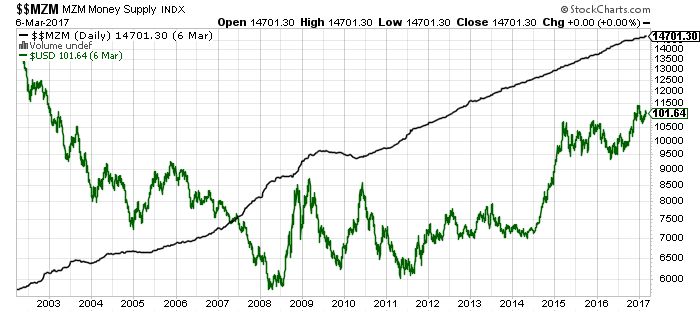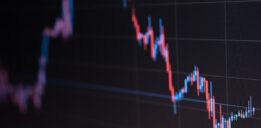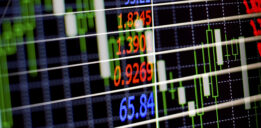How to Survive a Stock Market Crash
Stock market highs, corrections, and stock market crashes are inevitable parts of the economic cycle. With stocks at record levels, the question isn’t if there is going to be a stock market crash; there will be. The big question is, do you know how to survive a stock market crash? After you answer that, you need to determine the best ways to prepare for one.
After years of warning, is 2017 going to be the year that the stock market crashes? By all accounts, Donald Trump will be at the helm for the next crash. How can we be certain? Stocks are at record levels and the current bull market is the second-longest in history. Stocks are also significantly overvalued.
Keep in mind that the stock market is only as strong as the underlying stocks that make up the market. Oddly enough, U.S. stocks are at record levels, at a time when the U.S. economy remains very weak.
Again, a stock market crash is inevitable. And how you handle the next stock market crash could determine how you live out retirement.
Stock Market Is Significantly Overvalued
Stocks don’t crash because they’re fairly valued and being supported by a strong economy. Stocks crash, in part, because they are overvalued. And right now, stocks are significantly overvalued.
The cyclically adjusted price-earnings (CAPE) ratio, which helped Robert Shiller earn the Nobel Prize in Economics in 2013, compares current prices to average earnings over the last 10 years. The ratio currently stands at 29.24; the long-term average is 16. This suggest the S&P 500 is overvalued by 82.75%. The CAPE ratio has only been higher twice, it was at 30 in 1929 and at 45 in 1999. (Source: “Case-Shiller P/E Ratio,” Yale University, last accessed March 20, 2017.)
The market-cap-to-GDP ratio also points to a significantly overvalued stock market. The ratio, which is also known as the Warren Buffett Indicator, is at 130.5%. A reading of 100% suggest stocks are fairly valued. The ratio has only been higher once since 1950; in 1999, it was at 153.6%.
The Wilshire-5000-to-GDP ratio is at an all-time high of around 140.5. (Source: “Wilshire 5000 Total Market Full Cap Index©/Gross Domestic Product,” Federal Reserve Bank of St. Louis, last accessed March 20, 2017.)
Investors may not care about valuations right now. Instead, they may be more focused on technicals and trust that President Trump’s economic policies will be good for Wall Street. But that cannot go on forever.
Investors dismissed valuations during the dot-com era, until they didn’t. With no fanfare or warning, stocks started to sell off in March 2000. When the dust settled, the NASDAQ had plunged 80%, and by October 2002, the S&P 500 had lost approximately 50% of its value. Stocks will eventually sell off again; they just have further to fall this time.
U.S. Economy Remains Weak
The Federal Reserve may have confidence in the U.S. economy and believe it is strong enough to support rate hikes, but that’s open for debate. During President Obama’s reign, gross domestic product (GDP) growth averaged just 2.3%. In his last year in office, it was a princely 1.6%.
Before the financial crisis (going back to World War II), U.S GDP was routinely above three percent. In fact, if you look at U.S. GDP growth over 10-year increments, starting from 1948 (when declines from wartime spending ended), average GDP was robust. Until 2008, that is. (Source: “GDP Growth (annual %),” The World Bank, last accessed March 20, 2017.)
| Years | GDP Average |
| 1948-58 | 3.80% |
| 1958-67 | 4.28% |
| 1968-77 | 3.18% |
| 1978-87 | 3.15% |
| 1988-97 | 3.05% |
| 1998-2007 | 2.99% |
| 2008-2016 | 1.89% |
Even if we cook the books a little and remove the negative annual GDP from 2008 of -0.3% and -3.1% in 2009, a courtesy given to no other decade, the average GDP growth rate for the 2008–2016 period is still just 2.09%—almost a full percentage point below the previous decade’s.
With that in mind, the Federal Reserve’s guidance for 2017 and 2018 GDP growth of 2.1% doesn’t really seem like anything to get excited about. Should the U.S. economy even reach that level.
What’s going to get the economy to President Trump’s campaign pledge of four-percent annual GDP growth? Not jobs. Since the so-called recovery, most of the jobs created in the U.S. have been low-paying, part-time jobs. Wage growth has been virtually non-existent, U.S. household debt levels are approaching pre-recession highs, 56% of Americans have credit card debt of at least $15,000, and only four percent of American households are debt-free.
Stocks are at record levels and the average American isn’t doing all that well. In this climate, it’s going to be pretty tough to suggest the stock market is going to continue climbing to record levels in the coming months.
If anything, the realization that artificially low interest rates are behind the record run on Wall Street, and not fundamentals, will drive income-starved investors to the exits. When that happens, the panic will set in, the selling will start, and stocks will crash.
U.S. Debt Levels Have Soared
Since 2008, the national debt has soared from $5.8 trillion to almost $20.0 trillion. The national deficit is also at around $600.0 billion. This doesn’t really impact us right now because interest rates have been at historic lows, but when interest rates return to normal levels, this massive debt will have a huge impact on Wall Street and corporate earnings.
What did the U.S. get for the $4.23 trillion of debt purchased by the Fed between December 2008 and September 2012? Artificially low interest rates that sent stocks to irrational levels and an artificially strong U.S. dollar.
I say artificially strong because the purchasing power of the U.S. dollar has plunged. Since 2003, the money supply has surged 154% while the value of the U.S. dollar has declined 13.3%.
Chart courtesy of StockCharts.com
Further, President Trump’s tax policies could lead to a U.S. dollar collapse in 2017. The dollar may have great momentum and the U.S. Dollar Index may be at its highest level since 2003, but Donald Trump’s proposed tax cuts, deregulation, and protectionism (trade wars) could lead to a collapse in the U.S. dollar and an economic collapse.
The U.S. dollar only looks strong because other economies are doing so poorly. Should Donald Trump’s economic action plan not come to fruition or garner the kind of results he’s promising, it will put the real shape of the U.S. economy in the spotlight. Especially if a trade war erupts with China, Mexico, or Europe. Premature Fed rate hikes could also send the U.S. dollar spiraling and trigger an economic collapse.
Suffice it to say, this could usher in a stock market collapse.
Tips for Surviving a Stock Market Crash
There are a lot of stock market crash predictions out there and tips for surviving a stock market crash. For the upcoming stock market crash, you’ll need to look elsewhere for tips on how to store water, ammunition, and canned goods.
Oddly enough, most survivalist web sites seem to think one of the best ways to survive an economic collapse is by selling your stocks and running for the hills. That would be a mistake.
Yes, timing is everything, but stock market crash predictions are few and far between. Not even the world’s most famous contrarian investors, like Marc Faber, Jim Rogers, or George Soros can predict when the next stock market crash is going to happen. But as are contrarians, they’re prepared for the inevitable stock market crash when it does happen.
Now, volatility might bring the stock markets down, but volatility also has a short shelf life. And to survive a stock market crash, you need to take advantage of this window of opportunity.
Time Is on Your Side
Historically, stock markets recover from five-percent to 10% pullbacks within a couple months. In early 2016, the S&P 500 plunged around 10%; it took two months for the markets to make up that lost ground. In September 2014, the S&P 500 fell around eight percent and had recovered a month later.
When markets experience a 10% to 20% correction, it can take, on average, four months to rebound. Though that didn’t hold true for the 2008/2009 crash where the S&P 500 lost more than 50% of its value. After bottoming in March 2009, it took the index four years to get to its pre-crash level.
But even here, it’s important to remember that it did recover. And it has, like all other crashes, gone on to record levels. Some investors may be running for the exits, living by the “sell high, buy low” strategy, but this won’t help you navigate stock market volatility or survive a stock market crash.
Put It in Perspective
Another way to prepare for a stock market crash is to put it all into perspective. Even when the markets experience a serious correction, those who stay in are still ahead of the game. When the S&P 500 fell around 10% in April 2010, it was still up almost 60% from March 2009 lows. Instead of seeing a correction as a negative, it should be viewed as an opportunity for additional profits.
Don’t worry about trying to time the market’s bottom. Those who do miss it when it occurs and then wait too long to get back in. When the markets are crashing, buy as much of a good stock as you can. When a stock market correction or crash happens, virtually every stock gets affected: the good, the bad, and the ugly. If it was a good stock before the crash, it’s a good stock during, and it’ll be a great stock after.
Speaking of which, what happens after a stock market crash? That’s right, a bull market. Since its inception in 1928, the average annual return for the S&P 500 is approximately 10%. Since 1982, the average is almost 13%.
The best way to take advantage of a bull market is to find excellent stocks that were hit by the market sell-off. If it wasn’t, don’t buy it, because it probably won’t climb in step with the rest of the market. Stock market crashes and corrections are about the opportunity of buying great stocks cheaply.
Play Defensively
Besides, chances are good that you already own a number of high-yield, high-growth dividend stocks that provide income during times of turbulence and long-term capital appreciation. This includes defensive, or non-cyclical, stocks, equities that tend to perform better than the broader market when stocks turn bearish.
Great defensive stocks have a long history of raising their dividend yield annually; meaning, they make money whether the markets are going up, down, or sideways, and they pass that money onto investors with consistently higher dividend payouts.
They are able to do this because they manufacture products—non-durables—that everyone needs no matter what, including shampoo, toothpaste, deodorant, shaving cream, etc. Come to think of it, people also like to smoke and drink when times are good and bad too.
Buy When There’s Blood in the Streets
Again, more investor psychology: buy when everyone else is selling. It’s not just an adage the world’s top investors say; it’s a profitable strategy they follow religiously. And it’s not as if the strategy doesn’t work. Nathan Rothschild, an 18th century nobleman, is credited with saying, “the time to buy is when there’s blood in the streets.” He is also credited with saying, “Buy on the sound of gunfire.”
Both seem to work. And helped him make billions (today’s equivalent) on the Battle of Waterloo. Most expected Napoleon to win the Battle of Waterloo, but Rothschild put his financial support behind the Duke of Wellington. If Napoleon won, share prices would collapse. But if his gamble paid off, the markets would soar.
As the battle was coming to an end, Rothschild had agents surreptitiously bring the news back to London one day before anyone else knew. On June 18, 1815, Rothschild sold, with others following suit. Late in the day, he returned to the market and snapped up everything he could on the cheap. When news broke the following day, the markets soared.
The axiom has helped investors like Warren Buffettt bank billions. In 2011, Warren Buffett bet $5.0 billion on the then-struggling Bank of America Corp (NYSE:BAC). In late 2006, Bank of America was a high flying stock trading near $54.00 per share; but the stock tanked on fears it might not be able to meet its legal problems following the subprime mortgage meltdown. By March 2009, it was trading for well under $4.00 per share.
Enter Warren Buffett. In August 2011, he purchased $5.0 billion in preferred Bank of America stock when it was trading near $7.00 per share. He was also paid a six-percent annual dividend. This alone put $300.0 million a year into his bank account. If the Bank of America wants to buy back his shares, it has to wait until 2019 and would have to pay a five-percent premium on the share price to do so.
Buffett was also given warrants to buy 700-million shares of common stock in Bank of America for $7.14 per share until September 2021. Bank of America is trading near $25.00 per share. If he exercised the warrants, he would earn $12.0 billion. Toss in the annual dividends and Buffett is up a hefty $13.5 billion. Buffett still believes Bank of America has room to run and said he would wait to exercise the warrants until the last moment. (Source: “Warren Buffett Has a Paper Gain of $13.5 Billion From His Bank of America Bet,” Fortune, February 24, 2017.)
The best investors understand that stock market crashes and corrections, where investors dump everything, no matter how good it is, are excellent long-term opportunities. It can help small investors turn $10,000 into $100,000 and turn millionaires into billionaires.







